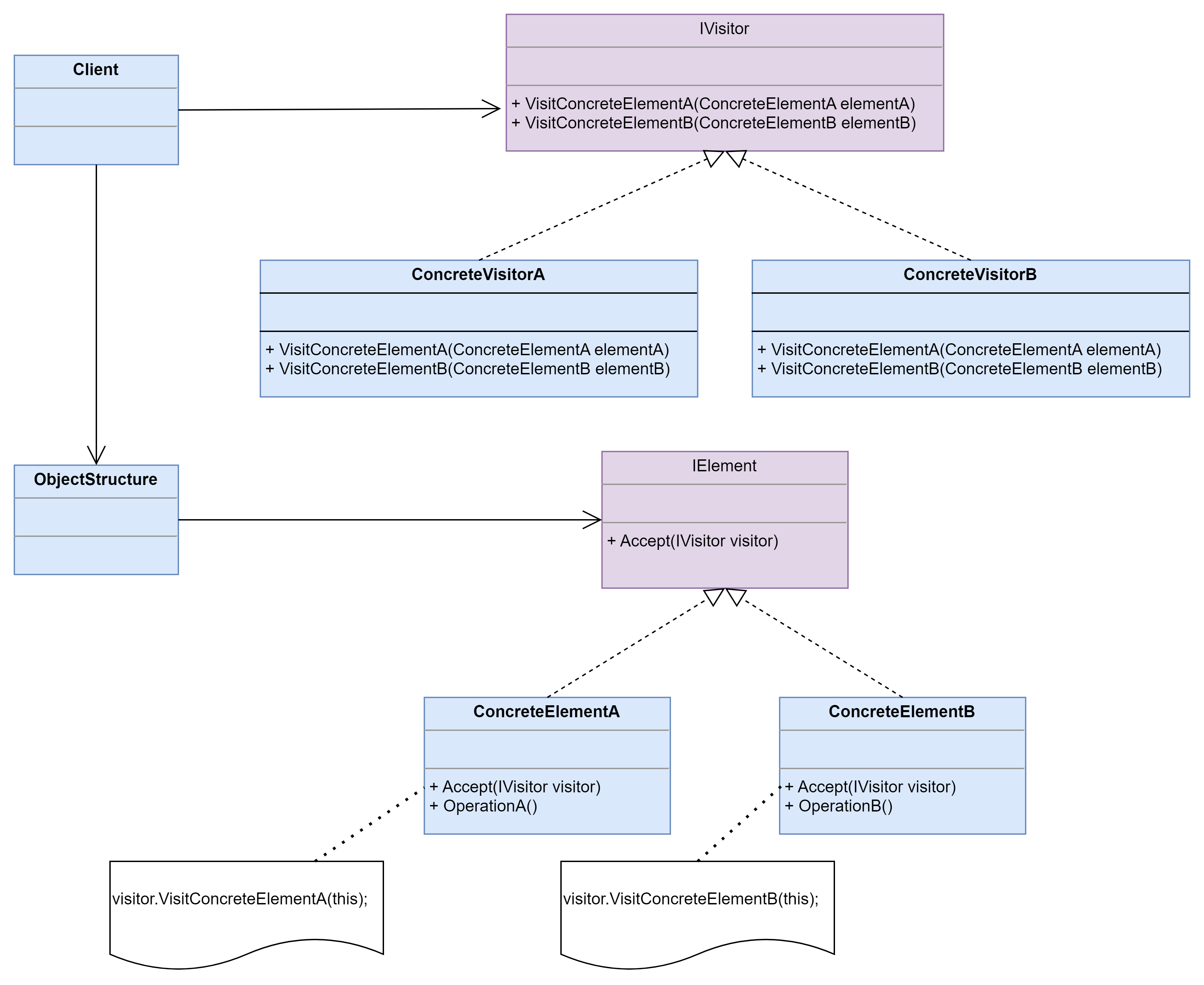访问者模式 (Visitor Pattern) - 操作复杂对象结构
提供一个作用于某对象结构中的各元素的操作表示,它使我们可以在不改变各元素的类的前提下定义作用于这些元素的新操作。访问者模式是一种对象行为型模式。
结构图
- Vistor(抽象访问者):抽象访问者为对象结构中每一个具体元素类ConcreteElement声明一个访问操作,从这个操作的名称或参数类型可以清楚知道需要访问的具体元素的类型,具体访问者需要实现这些操作方法,定义对这些元素的访问操作。
- ConcreteVisitor(具体访问者):具体访问者实现了每个由抽象访问者声明的操作,每一个操作用于访问对象结构中一种类型的元素。
- Element(抽象元素):抽象元素一般是抽象类或者接口,它定义一个Accept()方法,该方法通常以一个抽象访问者作为参数。
- ConcreteElement(具体元素):具体元素实现了Accept()方法,在Accept()方法中调用访问者的访问方法以便完成对一个元素的操作。
- ObjectStructure(对象结构):对象结构是一个元素的集合,它用于存放元素对象,并且提供了遍历其内部元素的方法。它可以结合组合模式来实现,也可以是一个简单的集合对象,如一个List对象或一个Set对象。
示例
using System;
using System.Collections.Generic;
namespace DesignPatterns.Visitor
{
// The Component interface declares an `accept` method that should take the
// base visitor interface as an argument.
public interface IComponent
{
void Accept(IVisitor visitor);
}
// Each Concrete Component must implement the `Accept` method in such a way
// that it calls the visitor's method corresponding to the component's
// class.
public class ConcreteComponentA : IComponent
{
// Note that we're calling `VisitConcreteComponentA`, which matches the
// current class name. This way we let the visitor know the class of the
// component it works with.
public void Accept(IVisitor visitor)
{
visitor.VisitConcreteComponentA(this);
}
// Concrete Components may have special methods that don't exist in
// their base class or interface. The Visitor is still able to use these
// methods since it's aware of the component's concrete class.
public string ExclusiveMethodOfConcreteComponentA()
{
return "A";
}
}
public class ConcreteComponentB : IComponent
{
// Same here: VisitConcreteComponentB => ConcreteComponentB
public void Accept(IVisitor visitor)
{
visitor.VisitConcreteComponentB(this);
}
public string SpecialMethodOfConcreteComponentB()
{
return "B";
}
}
// The Visitor Interface declares a set of visiting methods that correspond
// to component classes. The signature of a visiting method allows the
// visitor to identify the exact class of the component that it's dealing
// with.
public interface IVisitor
{
void VisitConcreteComponentA(ConcreteComponentA element);
void VisitConcreteComponentB(ConcreteComponentB element);
}
// Concrete Visitors implement several versions of the same algorithm, which
// can work with all concrete component classes.
//
// You can experience the biggest benefit of the Visitor pattern when using
// it with a complex object structure, such as a Composite tree. In this
// case, it might be helpful to store some intermediate state of the
// algorithm while executing visitor's methods over various objects of the
// structure.
class ConcreteVisitor1 : IVisitor
{
public void VisitConcreteComponentA(ConcreteComponentA element)
{
Console.WriteLine(element.ExclusiveMethodOfConcreteComponentA() + " + ConcreteVisitor1");
}
public void VisitConcreteComponentB(ConcreteComponentB element)
{
Console.WriteLine(element.SpecialMethodOfConcreteComponentB() + " + ConcreteVisitor1");
}
}
class ConcreteVisitor2 : IVisitor
{
public void VisitConcreteComponentA(ConcreteComponentA element)
{
Console.WriteLine(element.ExclusiveMethodOfConcreteComponentA() + " + ConcreteVisitor2");
}
public void VisitConcreteComponentB(ConcreteComponentB element)
{
Console.WriteLine(element.SpecialMethodOfConcreteComponentB() + " + ConcreteVisitor2");
}
}
public class Client
{
// The client code can run visitor operations over any set of elements
// without figuring out their concrete classes. The accept operation
// directs a call to the appropriate operation in the visitor object.
public static void ClientCode(List<IComponent> components, IVisitor visitor)
{
foreach (var component in components)
{
component.Accept(visitor);
}
}
}
class Program
{
static void Main(string[] args)
{
List<IComponent> components = new List<IComponent>
{
new ConcreteComponentA(),
new ConcreteComponentB()
};
Console.WriteLine("The client code works with all visitors via the base Visitor interface:");
var visitor1 = new ConcreteVisitor1();
Client.ClientCode(components,visitor1);
Console.WriteLine();
Console.WriteLine("It allows the same client code to work with different types of visitors:");
var visitor2 = new ConcreteVisitor2();
Client.ClientCode(components, visitor2);
}
}
}运行结果
1
2
3
4
5
6
7
The client code works with all visitors via the base Visitor interface:
A + ConcreteVisitor1
B + ConcreteVisitor1
It allows the same client code to work with different types of visitors:
A + ConcreteVisitor2
B + ConcreteVisitor2
总结
由于访问者模式的使用条件较为苛刻,本身结构也较为复杂,因此在实际应用中使用频率不是特别高。当系统中存在一个较为复杂的对象结构,且不同访问者对其所采取的操作也不相同时,可以考虑使用访问者模式进行设计。在XML文档解析、编译器的设计、复杂集合对象的处理等领域访问者模式得到了一定的应用。
优点
- 增加新的访问操作很方便。使用访问者模式,增加新的访问操作就意味着增加一个新的具体访问者类,实现简单,无须修改源代码,符合“开闭原则”。
- 将有关元素对象的访问行为集中到一个访问者对象中,而不是分散在一个个的元素类中。类的职责更加清晰,有利于对象结构中元素对象的复用,相同的对象结构可以供多个不同的访问者访问。
- 让用户能够在不修改现有元素类层次结构的情况下,定义作用于该层次结构的操作。
缺点
- 增加新的元素类很困难。在访问者模式中,每增加一个新的元素类都意味着要在抽象访问者角色中增加一个新的抽象操作,并在每一个具体访问者类中增加相应的具体操作,这违背了“开闭原则”的要求。
- 破坏封装。访问者模式要求访问者对象访问并调用每一个元素对象的操作,这意味着元素对象有时候必须暴露一些自己的内部操作和内部状态,否则无法供访问者访问。
适用场景
- 一个对象结构包含多个类型的对象,希望对这些对象实施一些依赖其具体类型的操作。在访问者中针对每一种具体的类型都提供了一个访问操作,不同类型的对象可以有不同的访问操作。
- 需要对一个对象结构中的对象进行很多不同的并且不相关的操作,而需要避免让这些操作“污染”这些对象的类,也不希望在增加新操作时修改这些类。访问者模式使得我们可以将相关的访问操作集中起来定义在访问者类中,对象结构可以被多个不同的访问者类所使用,将对象本身与对象的访问操作分离。
- 对象结构中对象对应的类很少改变,但经常需要在此对象结构上定义新的操作。
This post is licensed under CC BY 4.0 by the author.
